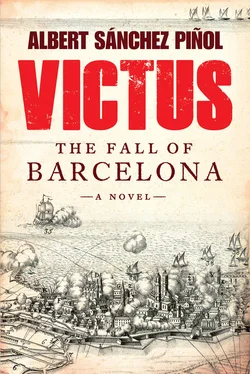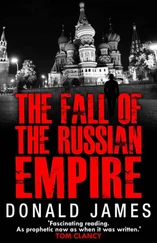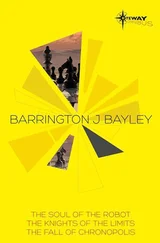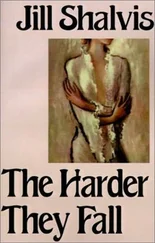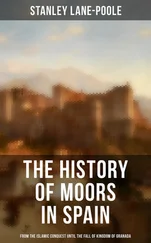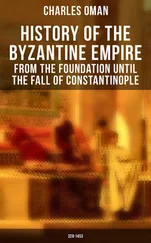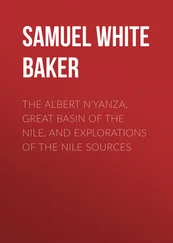A signal would be given (something other than a whistle, which the enemy would hear), and we’d run out to the trench, trying to stay low to the ground and silent. Their third parallel was so close by now that it was relatively easy to reach. However watchful the enemy was, we’d be upon them in seconds. Inside the trench, the strangest kind of combat would then commence. First slitting the guard’s throat, then, within minutes, securing part of the trench. The darkness of the night, the depths in which we had to maneuver, and the narrowness of the trench, all made it impossible to see anyone, though there were voices aplenty — howls of entreaty and rage. Whistles being blown by Bourbon officers, five or ten different languages being spoken. Our aims on these lightning attacks were to destroy sapping machinery, flood the trench floor and wreck the cannons. And there was good old Zuvi, directing the destruction. Of the cannons, above all.
Our men would climb all over the cannons like monkeys. One would hold a foot-long nail against the fuse entry point, and the other would pound it with a hammer. The cannon would be immobilized; when the enemy retook the terrain, it would be useless. Where possible, we’d steal their tools. The second wave of men was to follow behind, and when they had gathered a good amount of ammunition, including shovels and mattocks, we’d retreat.
We’d occasionally surprise sappers in the trench, and they wouldn’t put up any resistance. They’d crowd together, down on their knees, hands raised imploringly to the sky, begging for their lives. The flashes of gunfire, the momentary radiance of grenade explosions here and there, lit up their eyes. The last thing they’d experience would be a typically nightmarish scene: fleeing through the night, boxed in by walls sunk in the earth, reaching a dead end. A pitiless enemy coming after them. The best thing was not to look them in the eye.
“Shoot, Ballester, and be quick about it!” was the order I gave. “Kill them and move forward!”
In August 1714, neither side was taking prisoners. What would be the point? The bitterness we felt overcame us all. Falling back, we wouldn’t be able to take our wounded with us. Anyone left behind would be knifed to death by the counterattackers. And in the early hours of the following day, the cadavers would be flung over the front of the trench, and from up on the ramparts, we’d watch them rot in the August sun. A mad time. Everything had grown so dark, we could no longer recognize ourselves.
Anyway, to put aside the darkness for a moment. As an example of le Mystère ’s constant sense of humor, even when things were at their goriest, here is an anecdote from August 3 of that year.
I’d just gone in to see Don Antonio, my black hair whitened with ash and fragments of rubble. I was interrupted before I began my report, as in came a battalion of Black Pelts — senior priests, that is. They were there to present a Directive for the Assuaging of Divine Wrath.
The Black Pelts have always done a good line in sarcasm, so the only way to take it was as a not very funny joke. Read for yourselves the recipe they’d cooked up to bring about divine mediation and to liberate the city:
— Permanently put an end to street theater and comedies
Expel all gypsies from the city
Gather up the abandoned children which at this time swarm about in our streets
Do something about the profane, costly manners of the people of Barcelona
Bring back the veneration and respect of the temples
Hail Marys to be carried out in public places throughout the city
That Directive for the Assuaging of Divine Wrath plays in my memory as the perfect conjunction of all that is hypocritical and bizarre. The shelling had long since put an end to street theater, and no one had the energy to go and watch, or take part in, comedies. The poor gypsies, forever scorned, had seen the war as an opportunity to confront the stigma surrounding them: The majority of the drummers in the army had their dark faces. And if children were swarming the devastated streets, like my Anfán, it was because they were looking for food. As for “profane, costly manners,” what world were they living in? Our colorful, joyful city had for a long time been deformed and gray. On top of which, what possible link could there be between a siege in progress, divine favor, and silk skirts?
Don Antonio said he was in full agreement with them on every count. The next thing was that he sent them packing, using very florid language. They couldn’t have been happier.
Jimmy was a true Coehoornian. I couldn’t believe he’d taken so long to begin the assault. The trench wasn’t complete, sure enough, but what did that matter to someone who followed Coehoorn’s principles? In his hands, the Attack Trench (as my stay in the Mas Guinardó had told me) was nothing but a political instrument. The ramparts had been breached; he had a large, well-disciplined army at his disposal; and he scorned the “rebels,” scoundrels, for the larger parts, with very few trained troops among them.
So I failed to understand why the assault was taking so long to begin. My thoughts in designing the trench had been informed in large part by Jimmy’s tendencies. A premature attack would put us at an advantage. And there he was, to my dismay, holding his troops back. A strange duel because, even while Jimmy’s cannonballs were raining down, even as I was flinging myself to the ground to shelter behind the battlements, I was begging him: “Come on Jimmy, come on . Attack at last.”
The night of August 11, one of the hottest I can remember, found me behind the walls of Portal Nou. The majority of the militia went bare-chested. I made my way to the most forward position, where the remains of a wall stood like a gigantic corroded tusk, from there looking out at the Bourbons. I had a Coronela man with me, sent by the bastion commander to protect me.
“Quiet!” I said. “Do you not hear that?”
A hammering — thousands of mattocks and hammers. My Bazoches-sharpened hearing meant I could make them out, in spite of them covering the tools with cloth to muffle the sound.
I dashed back to the rearguard, not stopping until I found Don Antonio. I was gasping, having sprinted all the way.
“Carpentry, Don Antonio,” I said. “We’ve heard carpentry from their front line. They’re putting in the assault platforms, there’s nothing else it can be.”
Don Antonio showed no sign of emotion. I remember how he nodded, as though hearing happy news about an old friend. He looked me in the eye, seeking confirmation of the news. Still panting, I said: “They’re coming. It’s the general assault.”
To help form an idea of the battle that took place on the twelfth, thirteenth, and fourteenth of August, I here include a group of illustrations.
The below is the Saint Clara bastion and the large breach that had been opened by Jimmy’s cannons. The moat, full of rubble dislodged by the shelling, would be easy to traverse. The advance guard was just across from us, positioned on the “gentlemen.”
All we could do was create a line of defense inside the bastions themselves. Protecting this exposed line would be suicide, so ten feet or so behind the breaches, we erected barricades. These were of stone and cement, as solid as we were able to make them, and up to chest height.
One of Saint Clara’s few advantages was the Saint Joan tower, a tall, narrow construction behind and to the right of the bastion. Two light cannons had been stationed on it throughout the siege — light but very precise. The height of the tower gave it an excellent shooting angle. Saint Joan harrowed the Bourbons endlessly as they went about their trench works. They developed a loathing for the tower and sent endless cannonballs up at it.
Читать дальше
